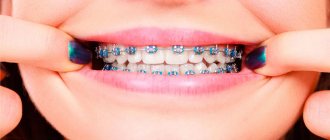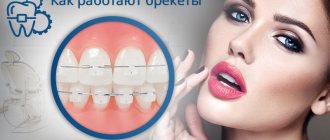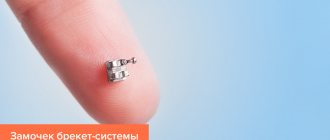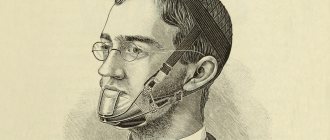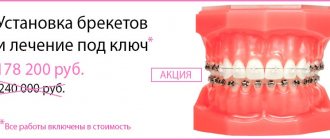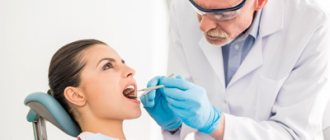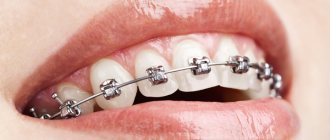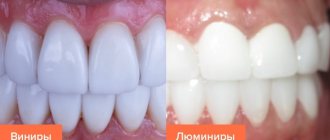Braces are the best way to correct bite anomalies of varying complexity in adolescents and adults. Many companies produce such equipment. To understand which design is suitable for the patient, it is important to know the features of brace system models. Implantmaster dental specialists have the skills to work with a variety of systems and select the best option for each specific clinical case.
Braces systems are designed to correct the position of teeth and jaw closure in adolescents and adults. Each age category has its own characteristics of the structure of the jaw bone and the time required to correct the position of the teeth. It is also important to consider the patient's psychological comfort. For some, the aesthetic qualities of systems are important, for others, the speed of achieving results or the material component.
The installation of various systems that correct the bite is carried out by our orthodontists. Doctors often improve their skills by attending training seminars and lectures. For successful work, the clinic has all the necessary high-tech equipment. We provide services at reasonable prices.
In this article you will learn when braces are installed and what types they are. Let's compare the characteristics of various braces systems and their costs. Let's determine what equipment is used for different ages.
Installation of braces in adulthood
Orthodontic treatment with braces in Russia goes back about thirty years. And in the USA, for example, bite correction with braces has been practiced for more than a hundred years. Russian orthodontists today often work with adults who simply did not have the opportunity to undergo this level of treatment in childhood. As a rule, such patients themselves turn to the dentist, less often - through the referral of related specialists. As a rule, people come to orthodontists for a beautiful smile, and not because of any pain. Most of those applying are women. Men are more relaxed about imperfect smiles, although doctors have recently noted an increase in the number of male patients.
Getting used to braces
The patient gets used to the braces system in the mouth within a couple of weeks. When the physiological movement of teeth begins, people experience discomfort due to aseptic inflammation of the bone. Patients with self-ligating braces stop feeling pain after a couple of days; when installing ligature structures, the discomfort goes away on the sixth day. The level of discomfort is influenced by the pain threshold, which is individual for each person.
Sometimes, at the initial stage of treatment, nitinol round wires cause discomfort. A glass of cold water relieves discomfort. Due to the physical properties of the thermal activity of the metal, the tension decreases and the discomfort goes away.
The metal of nitinol arcs is in one of two phases. When the temperature changes, the crystal lattice of the alloy changes from the martensite state to the austenite state and back. The doctor inserts a thermoactive arc into the grooves of the braces; under the influence of the temperature of the oral cavity, the arc straightens and gently pulls the teeth along with it. If the discomfort persists for a long time, the doctor prescribes painkillers to the patient.
Does it make sense to get braces as an adult?
Correcting a pathological bite or incorrect position of teeth is, of course, not a matter of life and death. Rather, it is a matter of regaining self-confidence. The “curvature” of teeth has little effect on communication; after all, we perceive a person holistically, and not solely the state of his bite. But, you see, an open wide smile of any person will make him more attractive in our eyes. And only people who are not embarrassed to show off their teeth smile like that. Plus, when we talk about bite, it's not just about beauty, it's also about functionality. Nature intended that when chewing, the load on the teeth should be distributed evenly - this is only possible with straight teeth and a healthy bite. If this is not the case, then over time a person develops problems with the dental system: pain appears, clicks when opening and closing the mouth, etc. Therefore, orthodontic treatment for adult patients is not only possible, but also necessary.
Features of caring for braces
In order to minimize the possible risks of damage to the teeth and the braces themselves, it is necessary to adjust the diet in terms of eliminating products with a viscous consistency that can stick to the teeth and can complicate care, provoking the development of caries:
- sweet bakery products;
- confectionery products, sweets;
- chips, snacks, sweet sticks.
Solid food should be crushed to avoid increased stress on the structures when biting. It is recommended to completely avoid sugary carbonated drinks in order to prevent tooth demineralization.
In terms of hygiene, there is a standard list of care rules taking into account the types of braces installed:
- You need to brush your teeth regularly and be sure to do so after every meal;
- use special tactics for cleaning braces, since these are the critical areas;
- It is recommended to undergo professional cleaning once every two to three months;
- use special hygiene products: floss, orthodontic brushes, irrigators.
Using all of the above recommendations eliminates any possible harm from the use of braces and is guaranteed to preserve the health, attractiveness and flawlessness of your teeth.
At what age does it make sense for adults to get braces?
In any case, there are no age restrictions. There are surmountable obstacles: the general condition of the teeth, periodontal and gum diseases, and possible common concomitant diseases. Absolute contraindications for installing braces for adults coincide with many other types of treatment: lack of teeth, tuberculosis, diabetes, a number of immune diseases, epilepsy, bone pathologies, blood diseases. If a person gets braces when he is over thirty, the treatment will be quite long, since tissue regeneration occurs more slowly due to age. Plus, skeletal growth has already been completed, and the position of the bones can be “corrected” only when they are still growing - in childhood and adolescence. However, dentists achieve excellent results with mature patients.
Indications and contraindications for installation
There are many indications for installing braces, but the main one is the alignment of the dentition, the correction of malocclusion (disturbance in the alignment of the upper and lower rows of teeth). Correct bite implies complete coverage of the lower incisors by the canines, and the chewing surfaces of the back teeth should touch the part that is closer to the inside of the oral cavity. Otherwise, there are indications for installing braces. This system is also recommended for the following jaw anomalies:
- Open bite. The dentition does not close in the lateral or anterior area. Installation of braces is one of the stages of treatment.
- Facial asymmetry. This pathology is most often caused by the hypertrophied development of one of the jaws, but the second jaw remains underdeveloped.
- Crossbite. It appears when one of the jaws is underdeveloped and slightly shifted to the side, however, both the lower and upper rows of the dental arch are not located exactly above each other.
- Crowded teeth. The teeth are rotated around their axis.
- Deep bite. The anterior part of the upper jaw excessively overlaps the lower jaw.
- Diastema and trema. Too much space between teeth.
- Distal bite. Violation of the position of the jaw (the upper one protrudes significantly forward).
- Medial bite. The lower jaw protrudes strongly forward. Most often, orthodontic appliances are used as the only treatment option.
The bite and development of the jaws are checked by a dentist whose specialty is orthodontics. It is he who prescribes treatment if necessary, and also installs the system in accordance with the type of bite.
Despite the fact that this is a fairly simple system that allows you to solve such global problems as correcting the bite, it has a number of contraindications; if they exist, wearing the structure is not recommended or is significantly limited. There is a conditional division of contraindications, which are relative and absolute.
16 photos in the style of what was then:
Relative ones are a temporary reason for refusing to use a system such as braces (the results will also be positive), after which the structure can be used. These reasons include:
- various neoplasms in the oral cavity;
- periodontal disease or periodontitis in the acute stage;
- the presence of metal implants in the oral cavity;
- bruxism (unconscious grinding of teeth during sleep);
- insufficient oral hygiene;
- allergic reactions to the material used to make braces;
- diseases of bone tissue with damage to the temporomandibular joint.
Absolute contraindications include those causes that cannot be eliminated. Therefore, to restore the correct bite position, orthodontists resort to other treatment methods. A contraindication to installing braces may be the presence of diseases such as:
- tuberculosis;
- diabetes;
- HIV;
- blood diseases;
- autoimmune diseases;
- oncology;
- mental illness;
- absence of a large number of teeth.
Those who are about to install a braces system are certainly interested in knowing what braces look like. However, this design is quite complex, so it is better to familiarize yourself with it at an appointment with a specialist or in a picture.
Specifics of treatment with braces in adults
Adult patients should keep in mind that it is often necessary to remove teeth to achieve a high-quality result of orthodontic treatment. This does not mean that every patient needs it; removal is carried out only in cases where there is not enough space to restore the normal position of the teeth. Foreign orthodontists change the jaw size of adults using surgery. In Russia, orthognathic surgery is not yet particularly widespread due to the fact that our patients are extremely reluctant to agree to undergo operations. Let us repeat that this is just information about how it might be. In most cases, orthodontic treatment for adults is limited to simply installing braces.
The most difficult period is the first 2–3 weeks
Correction of orthodontic defects is based on the use of natural processes occurring in the body. The first evidence of the beginning of correction is the so-called dissociation of the bite, when the dental ligaments and bone tissue are forced, under the influence of the orthodontic arch, to begin to work in a new way.
This process can become very unpleasant for an unprepared patient: during the first few days, the closing of the jaws completely disappears, muscles begin to ache, and constant aching pain in the teeth appears and increases. If you are not used to it, braces can rub your cheek, tongue or gums, and in some cases, gum inflammation can even occur.
In fact, such a shock state of the dental system serves as excellent confirmation that the process has begun. But there can be no talk of a visual effect in the first few weeks of treatment.
Which braces are most often installed in adults?
It is most rational to choose metal braces: they are the most durable, and since the treatment will be long, this is one of the most important indicators. When it comes to minor corrections, aesthetic systems made of ceramics or artificial sapphires can be installed. But, let’s say, ceramic braces are quite fragile compared to metal ones. If the ceramic lock is chipped, you will need to remove it and install a new one. And this is a waste of time: when the lock is re-glued, the treatment can be considered to begin anew. When choosing a brace system, it is best to listen to the orthodontist’s recommendations - the doctor selects or combines types of structures so that the treatment is as comfortable as possible.
Stage No. 2. Diagnostics
Diagnostic measures usually take from half an hour to an hour and consist of the following:
- orthopantomogram - a panoramic image of both jaws;
- teleroentgenogram (TRG) - a photograph of the skull in frontal and lateral projection;
- photographing teeth, as well as the face in profile and full face;
- taking impressions of both jaws.
Based on the diagnostic results, the doctor draws up an individual treatment plan for braces and virtual simulation of the result. All information is entered into the outpatient card, and the patient is referred to doctors of related specialties.
Is it possible to correct an adult's bite without braces?
You can - with the help of aligners. These are orthodontic transparent aligners made of solid polymer. Despite their rather simple appearance, aligners cope well with both minor changes in the position of the teeth and quite serious pathologies of the dentofacial apparatus. When treating with orthodontic aligners, patient motivation is extremely important. Aligners are more often chosen by men - they think that this type of treatment is less problematic. But they often lack patience and remove the aligners as soon as they feel discomfort. And this is unacceptable if the patient expects a positive effect of treatment. Aligners need to be worn 22 hours a day - keep this in mind before choosing this treatment option. If you comply with this requirement, then treatment with braces will not be necessary - mouthguards are no less effective at restoring the anatomically correct position of the teeth and correcting the bite.
Alternative to treatment with braces
An alternative to braces is aligners. Transparent hard aligners are used to move teeth in cases where the patient has increased aesthetic requirements. The aligners are made in the laboratory on a 3D printer based on an impression of the jaws. Patients change aligners in the order specified by the doctor. The disadvantage of aligners is the high cost of treatment, but the advantage is the aesthetic component: the aligners are invisible to others. Treatment with aligners takes longer and is suitable for clinical cases of mild to moderate complexity.
The doctor attaches attachments made of composite material to the teeth, on which the mouth guard presses. The teeth move slowly; halfway through the treatment, the orthodontist takes an impression of the jaw and sends it to the laboratory to make new aligners.
What are the best “adult” braces according to reviews?
Most adult patients respond positively to lingual braces. They are fixed on the back surface of the teeth and are absolutely invisible to others. This type of braces has the lowest profile: the clasps of the systems are lower than all others, and therefore do not interfere with diction, do not irritate the mucous membranes, and do not scratch the tongue. Adults also often choose non-ligature ceramic braces - they are practically invisible, quite durable and cheaper than sapphire structures. When choosing a vestibular system that is fixed on the front surface of the teeth, it is worth considering that no matter what invisible material its clasps are made of, the orthodontic arch will always be noticeable. Therefore, you can safely choose classic metal braces. Ultimately, preference for a particular design comes down to its price.
Materials for production
In this design, the raw materials that were used in the manufacture of the structure are also important, since each material has its own properties and characteristics. The most common bracket systems are those consisting of materials such as:
- Plastic. A system made from this material is the most affordable, but is used only if the treatment period is short-term. This system is quite impractical because the plastic, absorbing dyes, changes color very quickly. And also the structure of this material is very rough, which leads to the accumulation of a large number of bacteria on its surface.
- Ceramics. This is a special type of ceramic that is used only in dentistry. It has a large margin of safety (only metal is stronger). Its surface is very similar to natural tooth enamel and has a matte surface, which allows you to make braces almost invisible.
- Metal. The arc and fastenings are made from this material. Only medical alloys that do not cause allergic reactions and are not rejected by the body are used for these purposes. They are also resistant to external influences.
- Sapphire. In dentistry, only artificially grown sapphires are used, namely their single crystals. This material transmits light well, which allows it to remain invisible on teeth with fairly light enamel. This design is more fragile in comparison with the others, but still copes with its main functions perfectly.
Orthodontics has advanced quite a lot in the 21st century, so structures are made from the most comfortable and safe materials, and the effect of wearing braces before and after can exceed all expectations, but for this you need to be patient and also follow all the instructions of your doctor.
Retainers: why are they worn after braces are removed?
A retainer is a device that looks like an arch. It is placed on the back surface of the teeth when braces are removed. This way the new position of the teeth is secured. The ligamentous apparatus of the teeth has muscle memory, so no matter how we move the teeth, they will tend to return to their “original” position. Wearing a retainer is an essential part of orthodontic treatment. This is especially true for people over twenty-five years of age. A retainer is installed for at least two periods of wearing braces: for example, the patient wore them for one year, then the retainer will need to be worn for two years. Foreign orthodontists generally argue that you need to wear retainers constantly - this is the only way to guarantee that your teeth will remain straight. In general, after some time the retainer can be replaced with a night guard or plate. But some kind of structure supporting the new position of the teeth will definitely be needed - this is a classic. Unfortunately, patients often neglect this stage of treatment, experience relapses and begin to talk about the ineffectiveness and uselessness of orthodontic treatment in adulthood.
Operating principle
Structurally, braces are a rather complex technical system. Each tooth has its own bracket, and then they are all connected using an arch made of a special alloy. A distinctive feature of such an arch is that it is able to move and return to a given shape, which corresponds to the correct bite. Moving in a certain direction, the arch sets the teeth in motion, which move to where it is needed. The pressure force and arch rigidity required are not the same, so during the treatment process the orthodontist adjusts these parameters to achieve the desired effect. You can learn more about who an orthodontist is here. How often the rigidity of the arch should be changed is decided only by the doctor, who must take into account such parameters as the complexity of the pathology and the type of orthodontic structure.
How long should adults wear braces?
It is impossible to answer this question unambiguously: maybe one year, or maybe several years. Bite correction in adult patients is a long, labor-intensive process that requires patience and discipline. Therefore, orthodontists rarely persuade adults to straighten their teeth. If a person himself does not want this, then nothing will force him to conscientiously fulfill all the doctor’s demands. When treating adults with orthodontics, it is important that the dentist find a compromise between what he wants to achieve and what the patient wants to achieve. Orthodontists, of course, always strive to restore the perfectly aligned position of teeth, no matter how long it takes - at least three years, at least five years. The patient may get tired of the treatment and abandon it. The dentist’s main task is to honestly tell you how long the treatment will take and how it will proceed. And then hear whether the patient is ready to go this route.
Duration of treatment
It is almost impossible to name the approximate time it will take to completely eliminate malocclusion without appropriate examinations, since each case is individual. It is influenced by many factors, the main of which is the severity of the pathology. And also the duration of treatment may depend on the age of the patient and the characteristics of his body.
In order to understand how the treatment period is calculated, it is important to know that the teeth, which are fixed in the sockets, are quite firmly surrounded by soft tissues that can change their properties under constant pressure (they become more pliable). The bracket system exerts constant pressure on each tooth in the opposite direction, thereby promoting its displacement.
The only thing that can be said is that the period required for the tissues surrounding the tooth to interact with the system is at least one and a half years. If the case is very simple, you can limit the period to six months. Whereas the longest treatment can last up to five years.
Expert opinion
Ravcheeva Yulia Anatolyevna
General dentist
Orthodontics not only helps to straighten teeth and make a beautiful smile, but also restores impaired functions such as chewing and speech, which is very important in everyday life.
Price of braces for adults in Moscow
To avoid misleading you, we will not indicate specific amounts. Because orthodontic treatment for adults is time-consuming and often requires additional or preparatory procedures, its overall cost cannot be low. But the opportunity to smile broadly without embarrassment is priceless at any age! Therefore, it makes sense to schedule a consultation with an orthodontist, no matter how old you are. After examination and research, the doctor will tell you the exact cost of treatment in your case.
Result
Treatment with orthodontic structures requires considerable time and is associated with some inconvenience for the patient. But this is completely justified in terms of results, since defects are eliminated and a person no longer needs to be ashamed of his smile and hide it from the eyes of others.
Note: Treatment usually takes from one to two years, much depends on the complexity of the pathology and how the patient follows the doctor’s recommendations.
If the case is particularly complex, then we can talk about three or even four years, but this does not happen so often. Removing braces does not mean the end of treatment, since it will be necessary to wear retainers for some time, that is, plates that secure the result and will not allow the teeth to return to their original state.
General rules, the observance of which guarantees obtaining the desired result, are as follows:
- choose an internal or external version of the system based on the doctor’s recommendations, and not your preferences;
- Before installation, it is necessary to perform a complete sanitation of the mouth and cure all dental diseases;
- strictly follow the correction schedule and the doctor’s recommendations for oral care;
- wear aligners after removing the system to consolidate the results.
How much does it cost to install braces (for 2 jaws) –
1) Consultation with an orthodontist is usually free. 2) Diagnostics (taking and making impressions, analysis of control diagnostic models, calculation of TRG, analysis of orthopantomograms, which are necessary to draw up a treatment plan) - from 5,000 rubles.
3) Metal ligature braces −
- “Marquis” – price from 100,000 rubles,
- “Forestadent Sprint” – from 120,000 rubles,
- “Forestadent Mini-Sprint” – from 145,000 rubles,
- “Victory” – from 160,000 rubles.
4) Metal self-ligating braces −
- “Forestadent Quick” - from 125,000 rubles,
- “Damon Q” − from 155,000 rubles,
- “In-Ovation R” - from 160,000 rubles,
- "Empower" - from 160,000 rubles.
5) Ceramic braces −
- ligature - price from 125,000 to 160,000 rubles.
- non-ligated (self-ligating) - price from 140,000 to 220,000 rubles.
6) Braces made of artificial sapphire −
- ligature braces “Pure” – price from 125,000 rubles.
- ligature “Inspire-ICE” – price from 160,000 rubles.
- non-ligature “Damon clear” – price from 180,000 rubles.
7) Lingual braces −
- In-Ovation-L braces – price from 230,000 rubles,
- WIN braces – from 280,000 to 300,000 rubles,
- Incognito brand braces - from 450,000 to 500,000 rubles.
 Braces correction session (carried out once every 1-2 months) – from 1600 to 3000 rubles. Read more about prices for different braces options using the relevant links above.
Braces correction session (carried out once every 1-2 months) – from 1600 to 3000 rubles. Read more about prices for different braces options using the relevant links above.
